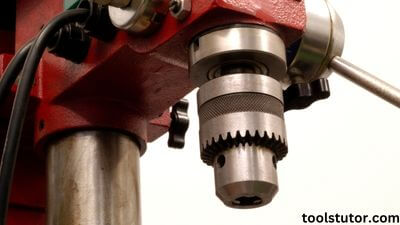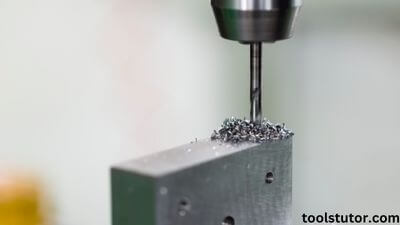A drill press is an essential piece of machinery for any workshop or garage. It allows for more accurate drilling than a handheld drill and can be used for a variety of tasks such as drilling holes, reaming, countersinking, and tapping. In this blog post, we will be explaining the different parts of a drill press so that you can better understand how this important machine works.
- Related article – Read about different types of drill press.
Anatomy of a drill press

Work Table
The work table of a drill press is one of the most important aspects of the machine, as it is where the workpiece is held in place during drilling. There are a few different types of work tables, each with their own advantages and disadvantages. The most common type of work table is the flat table, which is simple and easy to use.
However, flat tables have a limited surface area, which can make it difficult to drill larger pieces. Another type of work table is the vise table, which has a vise attachment that can hold larger workpieces. Vise tables are more versatile than flat tables, but they can be more difficult to use.
The function of the work table of a drill press is to support the workpiece during drilling. The table can be raised or lowered to adjust the depth of the drill bit, and it can also be tilted to drill at an angle. Some drill presses also have a built-in quill feed, which allows the operator to drill deeper holes without having to reposition the workpiece.
Head
The head of a drill press is one of the most important parts of the machine. It is responsible for holding the drill bit in place and translating the rotational motion of the drill bit into the linear motion of the drill press. The head must be able to withstand the force of the drill bit as it penetrates the workpiece. It must also be able to move the drill bit smoothly and accurately along the axis of the drill press.
The head of a drill press is responsible for housing the motor and gears, as well as the chuck which holds the drill bit. The head is mounted on the column and is able to move up and down, as well as swivel from side to side. This allows the operator to drill precise holes in a wide variety of materials.
Quill
The quill of a drill press is a cylindrical housing that contains the drill bit and holds it in place. The quill is mounted on a spindle and is driven by a motor, which turns the drill bit. The quill is lowered by a handle or a lever, which is used to control the depth of the hole being drilled.
Column
The column of the drill press is the main support of the machine, and it houses the drill bit, spindle, and chuck. The column must be perfectly vertical in order for the drill bit to create precise holes in the workpiece. The column is usually made of metal and is attached to the base of the drill press. The column is what allows the drill bit to stay in place while the drill press is in operation.
Spindle
The spindle of a drill press is the part of the machine that holds the drill bit in place and rotates it. The speed at which the spindle rotates can be changed, depending on the material being drilled and the size of the drill bit. The spindle is also the part of the drill press that moves up and down, depending on the depth of the hole being drilled.

Feed Handle
The feed handle is a lever that is used to control the speed at which the drill bit moves up and down. By adjusting the feed handle, the operator can control the speed of the drill bit, as well as the depth of the hole that is being created. The feed handle is an important part of the drill press, and it is important for the operator to be familiar with its operation.
Base
The base of a drill press is the bottom part of the machine that helps to keep it stable while in use. It is typically made from cast iron or steel and is bolted to the floor. The base also houses the motor and other key components of the drill press.
The base of a drill press is responsible for providing support and stability for the machine during use. It also houses the majority of the drill press’s mechanical components, including the motor, gears, and bearings. In some cases, the base may also contain a coolant system or dust collection system.
Drill bit
The drill bit of a drill press is an important tool that helps to create precise holes in various materials. This type of bit is designed to stay sharp and resist wear, making it ideal for repetitive drilling tasks. There are a variety of drill bits available on the market, each designed for a specific type of drilling application. When choosing a drill bit, it is important to consider the type of material you will be drilling, as well as the size and depth of the hole you need to create.

Motor
The motor on a drill press is responsible for providing the power necessary to rotate the drill bit at the desired speed. Drill presses typically have either an induction motor or a universal motor. Induction motors are more common on larger, industrial-grade drill presses, while universal motors are more common on smaller, bench-top models. The type of motor will determine the speed range and power output of the drill press.
The motor of a drill press provides the rotational force necessary to drill holes into various materials. The size and power of the motor will vary depending on the specific model of drill press. In general, however, the motor is an essential component of the drill press and is responsible for its primary function.
Drive belt
The drive belt of a drill press is a key component in the machine’s operation. The belt is responsible for transferring power from the motor to the drill bit, and as such, it must be able to withstand a considerable amount of force and heat. Over time, the drive belt may begin to deteriorate, which can cause the drill press to operate less efficiently. If the drive belt is not replaced in a timely manner, it may eventually break, which can cause the drill press to malfunction.
To know more about the parts of a drill press, you may check the below video:
Conclusion
In summary, a drill press is a machine tool used to drill holes in different materials. A drill press has many parts including the base, column, top plate, table, chuck, arbor, drill, tool rest, and drill bits. A drill press allows a user to make holes quickly and easily. There are many different models, styles, and sizes of drill presses so it is important to do research before purchasing a drill press.